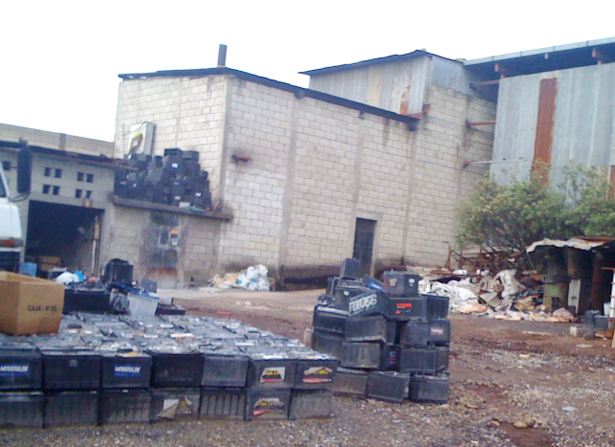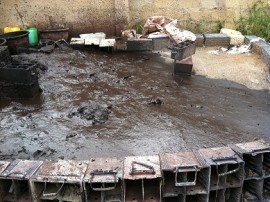Source #1
Battery Recycling
Description
Lead-acid batteries are rechargeable batteries that are most commonly used as automotive batteries in vehicles for starting, lighting and ignition (SLI). They consist of a plastic case containing lead plates with a lead paste submersed in dilute sulfuric acid. Lead-acid batteries are rechargeable, but eventually the lead plate material and paste breaks down and the battery can no longer hold an electrical charge. Such used lead-acid batteries (ULAB) are classified as hazardous waste under the Basel Convention and their disposal is regulated in all OECD industrialized countries. When used lead-acid batteries are recycled the battery, the plastic and the metallic components are separated. The plastics are recycled and usually used to manufacture more battery cases. The used lead plates and paste material are smelted to remove any impurities and cast into lead ingots.[1] Lead ingots are used in the manufacture of new lead-acid batteries, thereby making a continuous closed loop system.

In low and middle-income countries recycling of these batteries is a large industry as the lead in the batteries can be reused in various product-manufacturing processes. Countries with few lead ore sources are eager to collect and recycle lead-acid batteries to supplement their lead resources. The rising demand for automobiles in low and middle-income countries is driving the upsurge in demand for lead.[2]
Battery recycling contributes to almost 100 sites in the Blacksmith Institute’s database, potentially putting almost one million people at risk. Geographically the largest numbers of polluted sites are in Southeast Asia, with Africa, Central and South America also contributing a substantial amount. In addition, it is known that battery recycling is also a significant industry in South Asia and China as well.
Exposure Pathways
According to the Battery Council International, 97 percent of lead-acid batteries in the US are recycled. The risk of pollution in modern recycling plants is low because of the enforcement of strict environmental, health and safety standards, emission monitoring, stack scrubbers, dust control, and waste treatment. However, in the developing world informal recycling plants abound, set up by marginalized populations looking to capitalize on the growing market for recycled lead. In these informal recycling processes, used lead-acid batteries are broken up using hand axes or hammers, smelting of the metallic components occurs out in the open or inside domestic homes, and toxic waste products are disposed of into the surrounding environment untreated. In addition, some used lead-acid batteries are reconditioned by cutting them open, removing any defective plates, and sometimes the toxic sludge that settles on the bottom of the battery, and then resealing the cases. This type of recycling also leads to the dispersion of lead into the environment.
Emissions and fugitive dusts released from the smelting and casting of molten lead, and the unsafe disposal of solid and liquid waste are the main exposure pathways in informal battery recycling. When lead is smelted the fumes released condense into particulates, which can settle into the immediate surroundings and fall onto soil and waterways. Fugitive dust emissions also are deposited in the local area. Waste collected from these processes is often dumped into uncovered piles or directly into nearby waterways. Contaminants then leach into ground water and waterways used by local communities. The largest sources of exposure in the Blacksmith Institute’s database are ingestion of contaminated soil, particularly by children who often play in the dirt, or the ingestion of lead dust that has settled on food or inhalation of dust or emissions.
Top Pollutant(s)
The amount of lead and the highly toxic nature of the element make it the top pollutant at polluted battery recycling sites. Other pollutants include arsenic and cadmium. Lead causes a host of health problems and disproportionately affects children, causing developmental and neurological problems. Reference the health impacts of lead earlier in the report for more information.
Global Burden of Disease
Blacksmith Institute found that lead exposure was the single largest pollutant contributing to DALYs in the 49 countries assessed. Even with the severe underestimate of the scale of the issue, Blacksmith estimates DALYs from the lead-acid battery recycling industry were nearly 5 million in the 49 countries investigated. As a comparison, STDs (with the exclusion of HIV/ AIDs) in the countries reviewed accounts for 6.7 million DALYs.
What is being done?
It is recognized worldwide that informal recycling of used lead-acid batteries is hazardous and shipping batteries from developed countries to least developed countries for processing needs to be tightly regulated or prohibited. In 1989 The Basel Convention for the Control of the Transboundary Movement of Hazardous Wastes and their Disposal was negotiated through UNEP. This convention regulates the cross border shipment of hazardous materials from one country to another and is applicable to any developed countries looking for cheap disposal options. The Basel Convention entered into force as an international agreement in 1992 and has been ratified by over 170 countries, but the United States has never ratified the treaty.[3]
In addition the International Lead Management Center (ILMC ), created in 1996 by the international lead industry, offers hands-on advice and assistance from its experts to developing countries.[4] Working with the Blacksmith Institute in conjunction with the industry, the Basel Secretariat and the Regional Centers, together with the respective government and intergovernmental agencies, such as the UN International Lead.
Zinc Study Group (ILZSG ).[5] The ILMC assists with the management of the risks associated with lead and its impact on the environment and human health across all aspects of the lead industry from mining, smelting, refining and recycling. Remediation and education efforts can be very effective in addressing already polluted sites and preventing future pollution. In Senegal in the community of Thiorye Sur Mer, Dakar, the main economic activity was informal used lead-acid battery recycling. The practice was unregulated and often done in open-air settings, exposing some 40,000 people to lead dust. In March 2008, Blacksmith Institute was contacted about the death of 18 children under the age of five in the neighborhood of Thiaroye-Sur-Mer in Dakar. The University Hospital believed that the children all died from acute lead poisoning due to constant exposure to lead dust in the air, soil and water. Blacksmith tested 41 children’s blood lead levels - 100% of the children tested presented levels over 10 μg/dl, the highest being over 150 μg/dl. Blacksmith Institute, the Senegalese government, the University of Dakar’s Toxicology department, and Senegalese Ministry of Health and the ILMC were engaged to address the problem.
An educational program was undertaken in conjunction with local religious and village authorities to convey the dangers of exposure to lead dust. The local government initiated remediation efforts to treat the soil and surrounding environments and treat those people already exposed to lead. Policy changes are also in effect, targeted towards regulating ULAB collection, transportation, storage, and recycling. Following the joint intervention by Blacksmith Institute its local partners and ILMC, the contaminated area has now been cleaned up. Soil levels are now below 400 ppm (versus levels in excess of 400,000 ppm in some places. While children between ages of 1 and 5 years old were presenting blood lead levels in excess of 150 μg /dl in early 2008, the average blood lead level in that age group is now down to 53.457 μg /dl.
Since then the ILMC has continued to work with the Government of Senegal to introduce environmentally sound ULAB recycling and thereby prevent a recurrence of lead contamination in Dakar. The exercise in Senegal was a model of cooperation between local and international organizations for such contamination issues associated with lead pollution.
Footnotes:
[1] “Battery Recycling.” Battery Council International. Available at: http://www.batterycouncil.org/LeadAcidBatteries/BatteryRecycling/tabid/71/Default.aspx
[2] “The Basel Ban And Batteries, A Teaching Case: The Basel Ban And Batteries.” Available at http://www.commercialdiplomacy.org/case_study/case_batteries.htm
[3] “Basel Convention: Overview.” UNEP and The Secretariat to the Basel Convention. Available at: http://www.basel.int/TheConvention/Overview/tabid/1271/Default.aspx
[4] International Lead Management Center (TAB Member) - www.ilmc.org 20 2
[5] International Lead Zinc Study Group – www.ilzsg.org

-
Source #1
Battery Recycling
-
Source #2
Lead Smelting
-
Source #3
Mining and Ore Processing
-
Source #4
Tanneries
-
Source #5
Industrial/Municipal Dumpsites
-
Source #6
Industrial Estates
-
Source #7
Artisanal Gold Mining
-
Source #8
Product Manufacturing
-
Source #9
Chemical Manufacturing
-
Source #10
Dye Industry
-
The Remaining Five Sources



